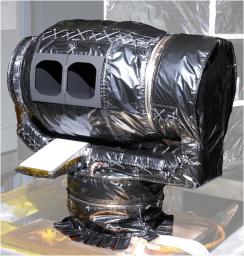The Mars Climate Sounder instrument, shown here prior to its installation onto NASA's Mars Reconnaissance Orbiter for the mission's 2006 launch, will get a similar-looking sibling at Mars in 2016.
The European Space Agency and NASA announced instrument selections in August 2010 for the joint European-American 2016 ExoMars Trace Gas Orbiter mission. One of the five selected instruments, the ExoMars Climate Sounder, will closely resemble this predecessor, which is about 40 centimeters (16 inches) across.
The Mars Reconnaissance Orbiter has been studying Mars with six instruments since 2006. Its Mars Climate Sounder has provided a lengthening record of the changing vertical distributions of temperatures, dust, water vapor and ice clouds in the Martian atmosphere.
The ExoMars Climate Sounder will extend that record with flexibility for seeing slices of the atmosphere at all times of day, due to a different orbital geometry. The ExoMars Trace Gas Orbiter will also carry instruments for detecting very low concentrations of methane and other gaseous clues about possible life on Mars. Information from the climate sounder will add context for understanding how transport and chemical reactions in the atmosphere affect trace gases.
The design for both the Mars Climate Sounder and the ExoMars Climate Sounder features two telescope "eyes" gathering infrared radiation measured in nine spectral bands. Two motors enable flexibility in pointing straight downward or toward the horizon in any direction.
NASA's Jet Propulsion Laboratory, Pasadena, Calif., supplied and operates the Mars Climate Sounder for the Mars Reconnaissance Orbiter and will supply and operate the ExoMars Climate Sounder for the ExoMars Trace Gas Orbiter. JPL also manages the Mars Reconnaissance Orbiter mission for the NASA Science Mission Directorate and manages NASA's roles in the 2016 mission. JPL is a division of the California Institute of Technology.

 Planetary Data System
Planetary Data System












